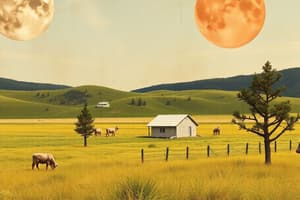Podcast
Questions and Answers
What is the main type of plant found in grasslands?
What is the main type of plant found in grasslands?
Grasses
What are two types of grasslands?
What are two types of grasslands?
Savannas and Temperate Grasslands
Which of the following is NOT a factor that maintains grasslands?
Which of the following is NOT a factor that maintains grasslands?
- Grazing animals
- Low precipitation rates
- Frequent fires
- High levels of precipitation (correct)
Grasslands are only found on one continent.
Grasslands are only found on one continent.
What are two examples of animals that live in herds in grasslands?
What are two examples of animals that live in herds in grasslands?
Which of the following is NOT a recreational use of National Grasslands?
Which of the following is NOT a recreational use of National Grasslands?
What are two services provided by National Grassland Ecosystems?
What are two services provided by National Grassland Ecosystems?
Grassland landscapes are very resilient to disturbance.
Grassland landscapes are very resilient to disturbance.
What is one way that grasslands are threatened by human activities?
What is one way that grasslands are threatened by human activities?
Which of the following is NOT a way to manage and sustain grasslands?
Which of the following is NOT a way to manage and sustain grasslands?
Prescribed burning can help control invasive species in grasslands.
Prescribed burning can help control invasive species in grasslands.
What is one way that communities can be involved in grassland management?
What is one way that communities can be involved in grassland management?
Flashcards
Grassland biome
Grassland biome
A large open area of grass, with few trees, maintained by grazing animals and fires.
Savanna
Savanna
A type of grassland with scattered trees.
Temperate grassland
Temperate grassland
A type of grassland found in temperate climates.
Precipitation in grasslands
Precipitation in grasslands
Signup and view all the flashcards
Grassland vegetation
Grassland vegetation
Signup and view all the flashcards
Factors maintaining grasslands
Factors maintaining grasslands
Signup and view all the flashcards
Grazing animals
Grazing animals
Signup and view all the flashcards
Frequent fires
Frequent fires
Signup and view all the flashcards
Wildlife in grasslands
Wildlife in grasslands
Signup and view all the flashcards
National Grasslands
National Grasslands
Signup and view all the flashcards
Grassland ecosystem services
Grassland ecosystem services
Signup and view all the flashcards
Threats to grasslands
Threats to grasslands
Signup and view all the flashcards
Conversion to agriculture
Conversion to agriculture
Signup and view all the flashcards
Overgrazing
Overgrazing
Signup and view all the flashcards
Species Composition Changes
Species Composition Changes
Signup and view all the flashcards
Hunting
Hunting
Signup and view all the flashcards
Sustainable Grazing
Sustainable Grazing
Signup and view all the flashcards
Restoration Efforts
Restoration Efforts
Signup and view all the flashcards
Prescribed Burning
Prescribed Burning
Signup and view all the flashcards
Habitat Fragmentation
Habitat Fragmentation
Signup and view all the flashcards
Biodiversity Promotion
Biodiversity Promotion
Signup and view all the flashcards
Monitoring and Research
Monitoring and Research
Signup and view all the flashcards
Community Engagement
Community Engagement
Signup and view all the flashcards
Policy and Regulation
Policy and Regulation
Signup and view all the flashcards
Study Notes
Grassland Biomes
- Grassland biomes are large, open areas primarily covered in grass.
- Trees are not common in grasslands.
- Grazing animals and frequent fires maintain these ecosystems.
- Examples of grasslands include savannas and temperate grasslands.
- Grasslands often occur between forests and deserts.
Grassland Precipitation
- Grasslands typically receive 500 to 900 millimeters (20 – 35 inches) of rain annually.
Grassland Vegetation
- Grasses are the dominant vegetation, including prairie clover, salvia, oats, wheat, barley, and coneflowers.
Grassland Locations
- Grasslands are found on every continent except Antarctica, including the Prairies of the Great Plains (North America), Pampas (South America), Savanna (South Africa), Steppes (Central Eurasia), and around deserts in Australia.
Factors Maintaining Grasslands
- The climate in grassland regions is ideal for grasses, as the low precipitation rates support grass growth but not enough for forests.
- Frequent fires help maintain the grassland ecosystem as grasses are well adapted to regrow after fire.
- Grazing by animals (like elephants) keep the ground clear of trees.
Importance of Grasslands
- Grasslands support high densities of grazing animals, such as zebras, antelopes, and the predators that prey on them (like lions, and cheetahs).
- National grasslands are rich in resources like minerals, oil, and gas.
- Recreational activities like mountain biking, hiking, hunting, fishing, and photography are common in these areas.
- The importance of grasslands for human well-being is highlighted across various sectors.
Threats to Grasslands
- Grassland landscapes are susceptible to disturbances.
- Conversion to agriculture, overgrazing, changes to species composition, and hunting of key species pose threats.
- Overgrazing is a common threat and occurs when too many animals graze on land for too long, making it unable to recover.
Managing and Sustaining Grasslands
- Understanding ecosystem dynamics (including plant species, soil type, and water availability) is crucial for management.
- Implementing sustainable grazing practices (like rotational grazing) helps prevent overgrazing.
- Restoring degraded areas that have been impaired by natural processes or human activities is necessary to maintain grassland health.
- Prescribed burning helps maintain grassland health and control invasive species while improving native plant growth.
- Preventing grassland fragmentation by maintaining larger contiguous areas supports biodiversity and ecological processes.
- Promoting biodiversity by providing various habitats like wetlands, meadows, and grassy patches is vital for a healthy grassland ecosystem.
- Monitoring of grassland health helps inform sound management decisions.
- Community engagement, raising awareness, and supporting responsible land use practices are essential considerations.
- Policies and regulations that support conservation, discourage habitat destruction, and support sustainable practices are needed.
Studying That Suits You
Use AI to generate personalized quizzes and flashcards to suit your learning preferences.




